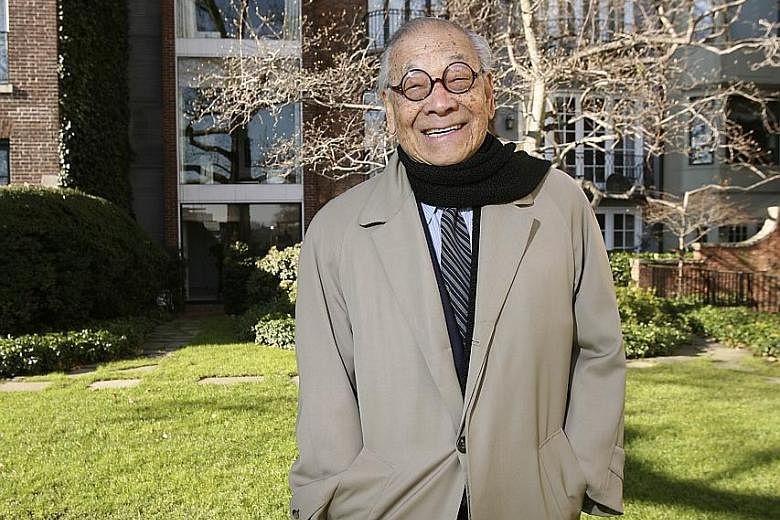NEW YORK • Mr I.M. Pei, the pre-eminent American architect who forged a distinct brand of modern building design with his sharp lines and stark structures, has died in New York, his sons' architecture firm said on Thursday. He was 102 years old.
From the controversial Louvre Pyramid in Paris to the landmark Bank of China tower in Hong Kong, the China-born Pei was the mastermind behind works seen as embracing modernity tempered by a grounding in history.
His death was confirmed by his son Pei Li Chung, who is also an architect and known as Sandi. He said his father had recently celebrated his birthday with a family dinner.
"Contemporary architects tend to impose modernity on something. There is a certain concern for history, but it is not very deep," Mr I.M. Pei, with his owlish round-rimmed glasses, told The New York Times in a 2008 interview.
"I understand that times have changed, we have evolved. But I don't want to forget the beginning," he added. "A lasting architecture has to have roots."
His work earned the 1983 Pritzker Prize, considered architecture's Nobel. Of his nearly 50 designs in the United States and around the world, more than half won major awards.
Mr Pei Ieoh Ming was born in Guangzhou on April 26, 1917, the son of Pei Tsuyee, one of China's leading bankers. He came to the US at 17 to study architecture, receiving an undergraduate degree in the field from the Massachusetts Institute of Technology in 1940.
He then enrolled in Harvard University's Graduate School of Design, where he received a master's degree in architecture in 1946. He became a naturalised US citizen in 1954.
In one standout undertaking, he deftly inserted into the monumental structures of the capital of his adopted country the modern angles of the East Building of the National Gallery of Art, opened in 1978. The stunning concrete-and-glass structure features huge mirrored pyramids and a 15m-high waterfall.
Then French President Francois Mitterrand was so impressed that he had Mr Pei hired to build a glass pyramid into the courtyard of the Louvre, the world's most visited museum. The project was deeply controversial in Paris, and Mr Pei endured a roasting from critics before the giant glass structure opened in 1989, but his creation is now an icon of the French capital.
"I received many angry glances in the streets of Paris," Mr Pei later said, confessing that "after the Louvre, I thought no project would be too difficult".
Other well-known and characteristic Pei projects - often graceful combinations of geometric planes - include the Rock and Roll Hall of Fame and Museum in Cleveland, Ohio; the Miho Museum of Shigo in Japan; the Morton Meyerson Symphony Centre in Dallas and The John F. Kennedy Library in Boston.
He brought drama to the Four Seasons Hotel in Manhattan and Raffles City in Singapore.
His Fragrant Hill Hotel in Beijing, completed in 1982, was intended to incorporate technology and indigenous building principles in a blend that would open the way to a particularly Chinese brand of modern architecture.
Despite being a confessed Islamic art novice, he was also commissioned to design the Museum of Islamic Art in Doha, Qatar, which opened in 2008 to great fanfare.
In 1975, Mr Pei was elected to the American Academy and Institute of Arts and Letters. Three years later, he became chancellor of the academy, the first architect to hold the position.
He was also one of 12 naturalised US citizens whom then President Ronald Reagan awarded the Medal of Liberty in 1986.
In 1988, Mr Mitterrand inducted Mr Pei as a chevalier in the Legion d'Honneur, later raising him to the rank of officier when phase II of the glass-and-stainless steel Grand Louvre pyramid was completed in 1993.
Mr Pei never played down his connections to China. His children were all given Chinese names, and when he won the Pritzker Prize in 1983, he used the US$100,000 award to establish a scholarship fund for Chinese architecture students.
His eldest son T'ing Chung, an urban planner, died in 2003. His wife of 72 years, Madam Eileen Loo, died in 2014.
In addition to his son Li Chung, he leaves behind another son Chien Chung, also an architect, who is known as Didi; his daugh-ter Liane; and grandchildren and great-grandchildren.
AGENCE FRANCE-PRESSE, NYTIMES

